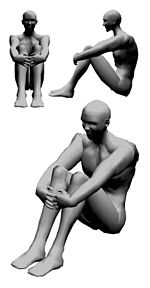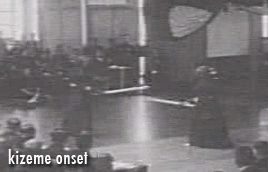The chair in Japan can be traced back to the Kofun period (ca. 250-538 AD), but it didn't really come in to favor until the Meiji era (ca. 1868-1912 AD). Even after the Meiji era, Japanese people still tended to sit on the floor. Nowadays in Japan as with everywhere else, there are chairs available everywhere. Traditionally, how one sits in Japan is based on the situation and the level of formality required. Here are some of the traditional ways Japanese people sit based on the formality of the situation.

Seiza (正座) is the politest and most formal way to sit for a man or a woman. Seiza is a difficult way for Westerners to sit and is becoming especially so in Japan as well most likely due to sitting in chairs. One sits with their legs folded underneath their thighs with their buttocks resting on the heels. The ankles turn outward to for a V with the toes touching. It is considered bad form and a sign of uncouthness to have the feet overlap. In Japan depending on the situation and level of formality, one might be required to sit in seiza. For instance, in Doshu's office there are chairs and tables and there is no need to sit in seiza because the atmosphere or context might not warrant any formality, but if Doshu were to be scolding you or if you were to be receive something official like rank then you might want to sit in seiza as sign of respect.
Yokozuwari or side sitting is an appropriate formal alternative to seiza for women. This is the way Disney's Princess Ariel sits with her tail wrapped behind her. Therefore a man who sits in yokozuwari might seem effeminate sitting this way.
Agura (胡座) or sometimes called anza translates as barbarian sitting is a more relaxed posture a man might take when they cannot sit seiza any longer or have a injury. It is formally known as cross legged. Generally, anza is an informal posture and not appropriate for formal occasions or for when a gesture of respect is need to be given. Women are not supposed to sit in anza, but that is changing in Japan.
Taiiku suwari is an alternative form for both men and women to sit. It is an informal style of sitting and can be seen in a physical education class where children are sitting on hard floors. One might use it as a rest position between seiza or anza to give their buttocks, knees or ankles a rest.
Obachan suwari or grandma sitting is where you sit in a modified seiza position where you don't sit on your ankles but sit between them. This style of sitting is often seen in Yoga class and is called Hero's pose. This is a seated position only for women unless of course one is taking a Yoga class.
Tatehiza (立て膝) can be for men and women but has grown into an informal way to sit. Tatehiza translates as standing knee and was designed as a way for warriors to sit on the battlefield in armor. So it is kind of weird gray area when it comes to formality. Sitting in tatehiza in a formal situation might come off as an affectation of politeness and thus seem disingenuous and rude especially since it came from the battlefield and might be misunderstood as a sign of contrariness or readiness to attack. Today we see this posture in casual settings and at the higher levels of Iaido techniques. It is actually not that easy to get into or  get out of in a pinch.
get out of in a pinch.















